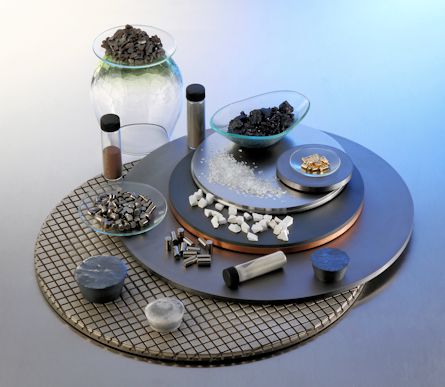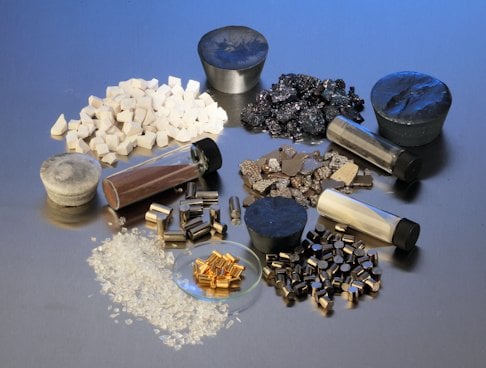
With the technological advancement in materials mining, processing and engineering, today’s coating materials market may contain tens of thousands of different choices of materials. When one adds custom material compositions and form factors, the choices are nearly endless. For the thin film designer, this is a beneficial outcome of the growth and maturity of the optical coatings materials industry. When selecting a coating material, it is paramount that the thin film engineer considers the advantages of the available options for their particular application.
When selecting the best material choice for your application, there are a number of factors to consider: the material itself, the form, and the process used to develop it. In perusing available materials, one finds many routes to the desired film including metals, alloys, inorganic compounds and cermets. There are also less defined items such as intermetallics and interstitial compounds. The producer of metallic materials tends to offer the end-user materials of higher purity and at, or very near, theoretical densities.
In addition to these various compositions, there is a large selection of form factors to take into account. Metals and most alloys are melted and subsequently swaged (hot or cold) to form rod or wire, or the molten material may be dropped through a sieve to form shot. There are also rods, pellets, tablets, granules, slugs, shaped sources, wire, turnings and a few others. Navigating through this supermarket of options can be a daunting task.
At its simplest, the choice of the form can be distilled down to ease of degassing, the length of the run and the ability of the material to form a stable pool or surface for evaporation. The less the surface area (larger particles, wire or shaped charges), the faster the producer can be ready to coat and the more stable the evaporating surface will remain during a run.
When examining the multitude of options available, you need to understand such driving factors as: balancing the desire to maximize the material in the pocket/boat with the risk of particle/charge fracturing, explosion or other detrimental reactions, and reductions or decompositions.
Deposition techniques for metals and a great number of metal alloys are quite flexible. Both resistive and electron beam evaporative techniques can be used successfully for most metals.
Integration of the use of gas in thin film deposition has allowed coaters to use metal source material to create a reactive process. While carbides are possible, the most common evaporative reactive films are oxide or nitride coatings. Use of metals in a reactive deposition can offer some advantages over direct use of the base compound. The high purity source material is reacted with high purity gasses to yield high quality films. The rates of such processes are often dictated by the heat load to the substrate or the prevalence of “spit” or “spatter” from large droplets of metal. Ion assisted deposition (IAD) is often used to ensure complete oxidation while some novel environments can be back-filled to assist with proper film properties. Even in this case however the stability of the melt pool or surface can be the most critical challenge over a run.
Widely available metals in the market have aided the growth of an industry for large area deposited metal films on a variety of substrates. Such films can successfully be deposited from pellets, shot, wire or a shaped source. Pellets or shot would typically be used in the case where a hearth, crucible or boat is employed; wire may be the choice where a heated pier or molten pocket is implemented.
Typical applications for metals in optics are reflector coatings, interference films and adhesion layers. One must consider the application when selecting appropriate materials. Many metal films exhibit excellent performance; however, some of the reflecting materials can be relatively soft or tarnish quickly when in thin film form. Overcoming these limitations may require a protective overcoat layer in the form of a dielectric compound material. Furthermore, as laser fluencies increase, the use of complicated “seed” and “protective” layers are employed to stave pure metal corrosion and enhance lifetime.
Comparatively speaking, the e-beam evaporation process of chemical compound coating often comes down to controlling unwanted side reactions, decomposition products or unstable melts. The Science and technique to overcome individual challenges to these key compounds has resulted in mature commercial market and specialists in different parts of the EM Spectrum. This is especially true for the visible wavelength region where glare reducing antireflective coatings are highly prevalent from a multitude of deposition techniques aligned to different performance characteristics.

Material properties and their synthesis method generally dictate the choice of fabrication and often ultimately impact what form the evaporation material should take. In the case of materials that start as Oxides, final methods chosen are generally a densification of powder process. This process usually takes the form of a classical ceramic bindering, pressing and firing (AKA cold press and sinter) or hot-press and billet with size reduction. The former can more easily yield material in specific geometries such as pellets or tablets, in addition to granules. The economics of hot-pressing lend themselves more towards fabricating granules.
There is concern that cold press and sinter processes often introduce organics and moisture-laden materials into the coating material; a final firing can be coupled to vacuum degassing. Hot-pressing processes typically do not use binders, and the final forms are generally limited to granules. The less thermal history a material has, or the higher surface area or internal granule porosity it exhibits, the more critical the initial burn-in procedure or pre-melting process is to achieving a consistent product.
While thermal evaporation processes of some Oxides such as ITO or SiO have been well developed, the majority (actually any material with an evaporation temperature >1200o C) of Oxide deposition work is performed by way of electron beam evaporation technique. These high vacuum evaporative processes pull oxygen off the source material risking absorption in the growing film. It is for this reason that a partial pressure of oxygen is frequently implemented. This requirement for the use of additional oxygen is often balanced with a material supplied in a slightly reduced or slightly oxygen-deficient state from the manufacturer. With such materials, processes are developed that take into consideration the rate of re-oxidation, the rate of evaporation and substrate factors such its preparation and temperature.
The DUV and the LWIR designs surpass the oxides common in the VIS spectrum and require increasingly sophisticated Fluoride compounds. Generally speaking, most of the Fluoride materials start from a wet chemical process where the resultant material is then subjected to a prescribed thermal process (melting, crystallization, etc), followed by a particle size classification. While pellets and tablets of Fluoride materials are available, the prevailing form is generally granules or pieces.
Fluoride materials present some inimitable challenges to the coating process. Fluorine loss in the evaporation process leads to absorption, instability or premature failure of key films. An optically optimum Fluoride thin film can have hygroscopic properties or require such delicate temperature controls that adhesion is difficult to maintain over long runs. Some evaporative Fluoride films exhibit columnar growth patterns which put pressure on the coating tools and Engineers to control. These challenges are typically met with techniques involving controlling the rate of deposition, having the appropriate chamber conditions, optimal material selection and post deposition treatment of the thin films.
With the utilization of best practices, Fluoride materials can be used in a multitude of sophisticated, multilayer precision optical designs. Fluoride materials are the subject of both longtime unchanging techniques and continuous improvement and investment as DUV and LWIR application development. As such, they are at the forefront of military, medical, microelectronic and aerospace excellence.
We offer the most comprehensive technical expertise, range of products and unique materials solutions available today. As specialists in the sourcing, reaction chemistry and production of critical thin film coating materials, we aid our customers in selecting the best available option from the myriad choices available.